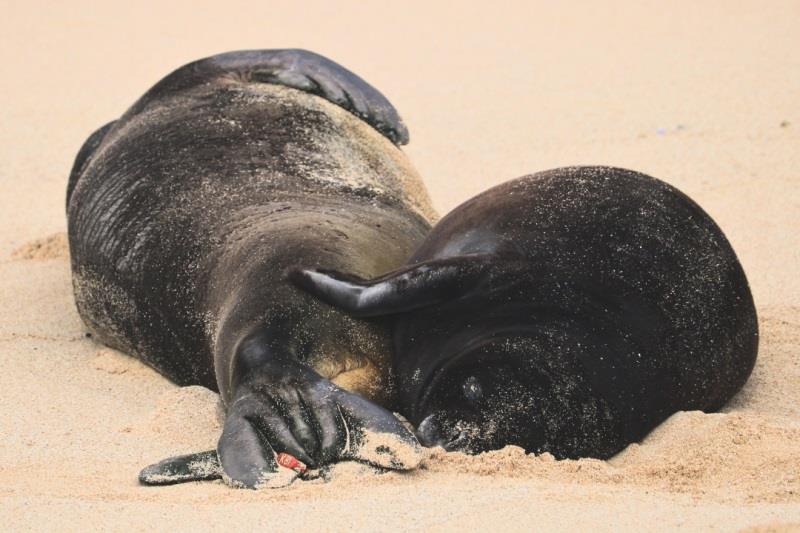
Meet Makana - One of the first Hawaiian Monk Seal Pups of 2024
by NOAA Fisheries 23 Mar 2024 23:07 UTC

Hawaiian monk seal RK80 (Keolakai) gave birth to her first pup, Makana, in February 2024 on O'ahu © Hawaii Marine Animal Response
Hawai'i Marine Animal Response partnered with Kahuku Elementary School to name the first Hawaiian monk seal pup of O'ahu in 2024.
Spring and summer are two of our favorite seasons when it comes to Hawaiian monk seals. Why? Because it's peak pupping season!
Hawaiian monk seals give birth year-round, but March through August is when we see the majority of these adorable—and endangered—pups make their debut.
We are excited to announce the first O'ahu-born Hawaiian monk seal pup of 2024! The pup was reported on February 6, 2024, on the north shore of O'ahu. We are working closely with our partners at Hawai'i Marine Animal Response to monitor and ensure that mom and pup are given lots of space. HMAR continues to provide outreach to beachgoers in the area.
"Our hardworking team members dedicate thousands of hours each year to help NOAA monitor pups and build public support for these magnificent animals through public outreach," said Jon Gelman, HMAR president and founder.
"It's an honor to watch over a new pup," he added. "Our dream is to see the population recover, and each successful pupping is a step toward realizing that dream."
The naming of PO1: Makana
Once a pup is born, our monk seal researchers give the pup a temporary NOAA ID. This young male's ID is PO1 because he's the first O'ahu pup of the year. But PO1 also recently received a very special name from the community—Makana.
The tradition of naming is important in Hawaiian culture. HMAR has a program with local schools that gives students the opportunity to name new pups. They also learn about these native seals and our collective kuleana (responsibility) to them.
For PO1, they worked with the fifth-grade class at Kahuku Elementary School. Students chose the name Makana because of the saying: He makana maika'i na makou, meaning "a lovely gift for us." Their teacher noted that "each time an endangered animal has a pup, we are overjoyed at the gift we receive by the furthering of the species."
"We were very excited to work with the class and give them the chance to name the first pup of the season," said Clara Orr, HMAR Marine Programs manager. "The students were incredibly creative and thoughtful with their name choice!"
Learn more about naming Hawaiian monk seals.
More About Mom: RK80
RK80, known as Keolakai, is one of the last pups born to the famous R5AY (Honey Girl). Keolakai translates to "the life, the health, and the well-being of the sea." It speaks to the life of the ocean manifesting life in the pup, and the pup manifesting life in the sea. Students at Hau'ula Elementary School gifted her this name. Like any new mom, this is a momentous celebration for Keolakai, since Makana is her first-ever pup. Hopefully, Keolakai will be a future matriarch like Honey Girl, continuing the recovery of their species.
Pupping Season Pointers
Monk seal mothers typically nurse their young for 5-7 weeks before heading off on their own. During this short time, it's vitally important for the pup to get the nourishment it needs to survive. Help these endangered pups by following these best practices:
- Give mothers with pups at least 150 feet of space on land and in the water—moms can be protective if they think you're too close
- Keep dogs leashed any time you're at the beach (you never know where a seal may be!)
- Report all seal sightings to our statewide NOAA Marine Wildlife Hotline: (888) 256-9840
Hawaiian monk seals are native to Hawai'i and are protected by
state and federal laws. To minimize potential disturbance, we typically do not publicly announce the specific location of a mother and pup. We appreciate the community's understanding and support during these crucial nursing periods. Let's admire from afar to keep everyone safe!
Learn more about monk seal pups.